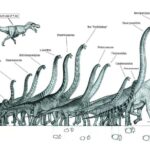The long necks of certain dinosaurs, such as the sauropods, have long intrigued both scientists and the public alike. These creatures, which include some of the largest animals to ever roam the Earth, like Brachiosaurus, Apatosaurus, and Argentinosaurus, were characterized by their incredibly long necks that could stretch over 30 feet in some species. So, why did these massive creatures evolve such an unusual feature? There are several scientific theories that seek to explain the development and function of these long necks, and they involve a fascinating mix of feeding strategies, environmental adaptation, and evolutionary pressures.
1. Access to a Wide Range of Vegetation
One of the primary theories behind the long necks of these dinosaurs is that they allowed them to access food that was otherwise out of reach. By having long necks, sauropods could feed on vegetation high up in trees, allowing them to exploit a feeding niche that was unavailable to many other herbivores of the time. In environments dominated by tall trees, this adaptation gave them an advantage in terms of food availability.
For example, Brachiosaurus, with its long neck and elevated head, could reach the tops of conifers and cycads that other herbivores couldn’t access. This would have been a significant advantage, especially during times of ecological competition. Having access to untapped food sources would help reduce the risk of starvation and ensure a steady food supply.
2. Feeding Efficiency and Grazing Flexibility
Long necks may have also enhanced the dinosaurs’ ability to graze over a larger area without needing to move much. Rather than constantly walking or moving between food sources, these herbivores could stretch their necks and feed across vast expanses, grazing on different plants without expending much energy. This would be especially useful for large animals that required immense quantities of food to sustain their size.
Additionally, a long neck could allow a dinosaur to feed on multiple types of plants at different heights, maximizing their food intake. Instead of competing with smaller herbivores for ground-level foliage, they could reach higher or even across different types of environments. This grazing flexibility would be a powerful evolutionary advantage, enabling long-necked dinosaurs to thrive in diverse landscapes.
3. Thermoregulation and Body Heat Management
Another theory suggests that long necks may have helped these dinosaurs with thermoregulation. The idea is that their long necks allowed them to manage their body heat more efficiently. As large creatures, sauropods would have generated vast amounts of heat. The long neck could have acted as a radiator, helping to regulate the animal’s body temperature by dispersing excess heat into the atmosphere.
This theory, though still debated, posits that the necks may have played a role in helping to maintain the dinosaurs’ thermal balance, especially in hot, prehistoric climates. The position and size of the neck might have enabled these animals to adapt better to their environments, where temperature control would be essential for survival.
4. Mating Displays and Social Signaling
Long necks may have also had a social function. In some animal species today, extravagant physical traits are used to attract mates or signal dominance. It’s possible that long-necked dinosaurs used their necks in a similar way, either as part of mating displays or to establish dominance within social groups.
For example, some paleontologists suggest that long necks may have been employed in head-butting contests or in displaying strength during courtship rituals. The long neck could have been a visual marker of size and fitness, signaling to potential mates that an individual was strong, healthy, and capable of defending territory.
5. Evolutionary Pressures and Gradual Adaptation
From an evolutionary standpoint, long necks may have been the result of gradual adaptation to changing environments and ecological pressures. As different species of dinosaurs evolved over millions of years, natural selection favored those with longer necks that provided access to food, offered mating advantages, or helped in thermoregulation.
Over time, these features would have become more exaggerated, leading to the development of the extreme necks seen in some species. Evolution often favors traits that give individuals a survival advantage, and in the case of long-necked dinosaurs, these adaptations likely helped them survive and thrive in the diverse ecosystems of the Mesozoic era.
6. Efficient Digestive System
Finally, long necks may have played a role in the digestion process. Sauropods had massive bodies that required huge amounts of food. Their long necks allowed them to take in more plant matter, which would be processed by their large, complex digestive systems. The ability to consume more vegetation from various sources might have been crucial for their survival, as it allowed them to obtain the nutrients needed to sustain their giant size.

Conclusion
The long necks of dinosaurs like Brachiosaurus and Apatosaurus were likely the result of a combination of ecological, biological, and evolutionary factors. These necks allowed the animals to access high vegetation, feed over large areas efficiently, and possibly even engage in social behaviors. Whether aiding in food acquisition, temperature regulation, or social displays, the long necks of these ancient creatures were a crucial adaptation that helped them dominate the Earth for millions of years. Understanding this evolutionary marvel continues to shed light on the complexity and wonder of prehistoric life.



